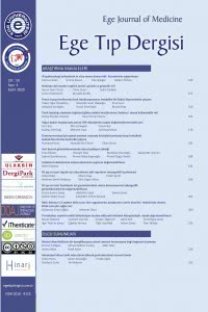The arterial distribution and size of greater omentum
- ISSN: 1017-7698
- Yayın Aralığı: Yılda 3 Sayı
- Başlangıç: 2018
- Yayıncı: Ege Üniv. Tıp Fak.
Hemodynamic changes during fibreoptic bronchoscopy: Midazolam, diazepam and opioid supplementation
Serir AKTOĞU, Levent HASEGELİ, M. Şevket DERELİ
Zinc in serum and breast milk in women who felt that their milk supply is depressed
Ayşe YENİGÜN, Figen OKSEL, Nurhan BOZDOĞAN, Baha TANELİ
Is infinity-L-fucosidase and sialic acid a diagnostic criteria in malignant pleural effusions ?
Serir AKTOĞU, Ömür ERKIZAN, Arzu YORGANCIOĞLU, Giray BOZKAYA
Canan ÇOKER, Fehmi AKÇİÇEK, Sara HABİF, Ayhan YILMAZ, Ahmet ÇOKER, Biltan ERSÖZ
Steady state relations of plasma zinc to copper and iron plasma levels in children
Figen OKSEL, Hüseyin KÖKSOY, Hayim BARUH, Baha TANELİ
Partial di George anomaly: with branchial fistula: case report
Erol MAVİ, Yeşim AYDINOK, Şükran DARCAN, F. Ferda ÖZKINAY, Sarenur TÜTÜNCÜOĞLU, Ahmet KESKİNOĞLU
Early free flap coverage of high-tension electrical injury: Case report
Mehmet ALPER, Cenk GÖRKEN, Ufuk BİLKAY, Yavuz KEÇECİ, Ecmel SONGÜR
Incidental lipoma in the wall of lateral ventricle (MR findings) : case report
Recep SAVAŞ, Christiane PÖCKLER, Friedemann GÜCKEL, Max GEORGI
Unilateral condylar notch of the temporomandibular joint: MRI and CT diagnosis
Orhan OYAR, Esin Emin ÜSTÜN, BİRGÜL ÖZPINAR, Münire Ece SABAH, Işıl GÜNHAN
A patient with Swyer sydrome presenting with gonadoblastoma and dysgerminoma
Nazan ÇETİNGÜL, Canan VERGİN, Kaan KAVAKLI, Ferda KÖPRÜBAŞI, Şükran DARCAN, Senay ÖZTOP, Erol BALIK, Yıldız ERHAN, Güngör NİŞLİ
